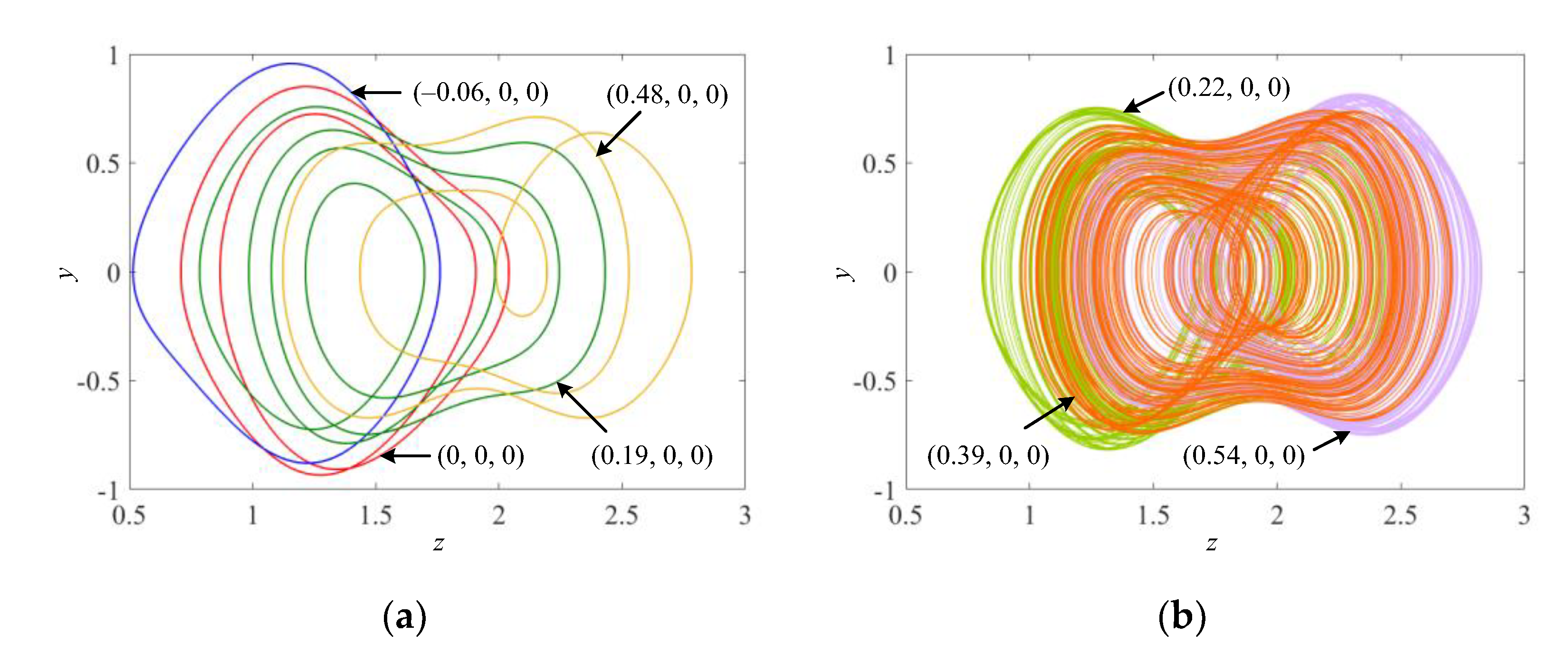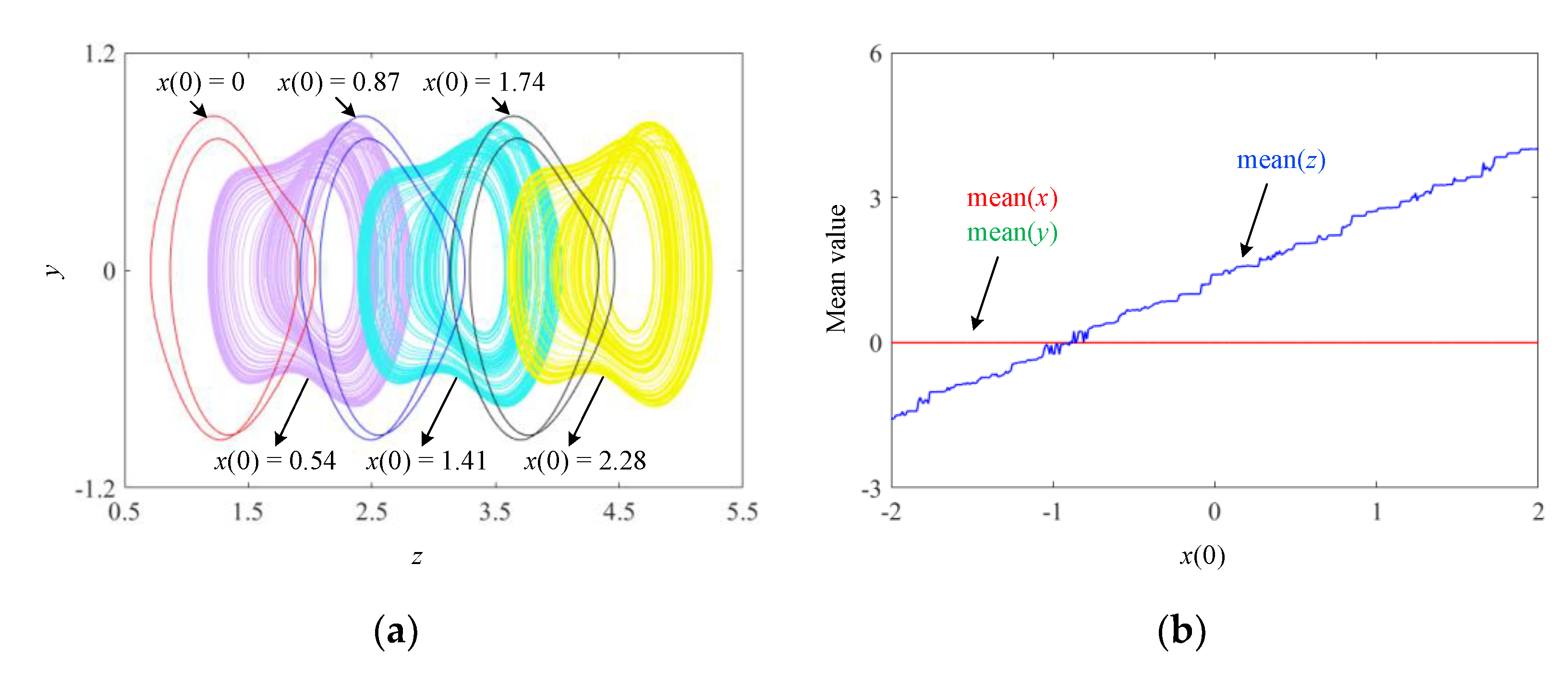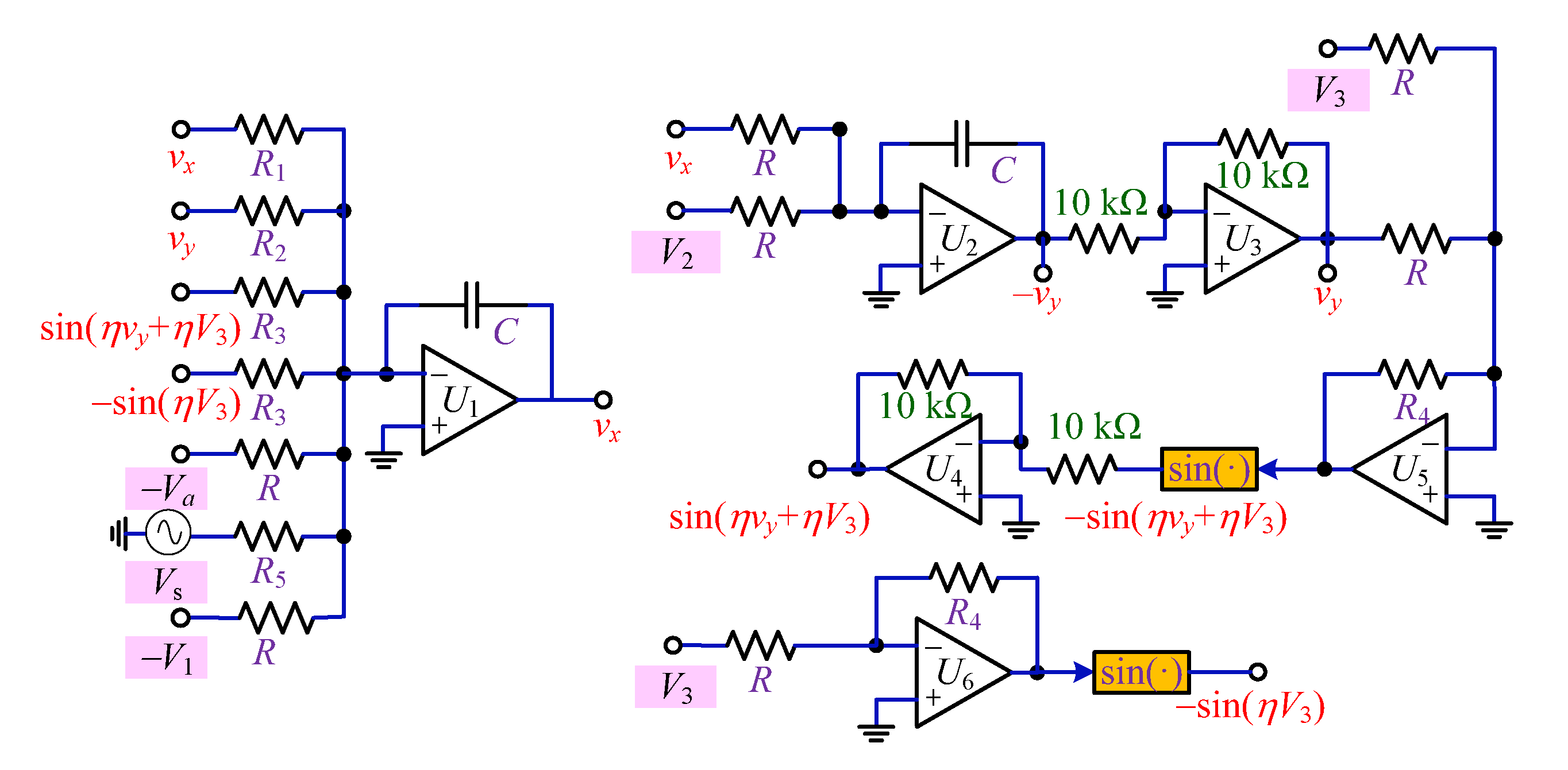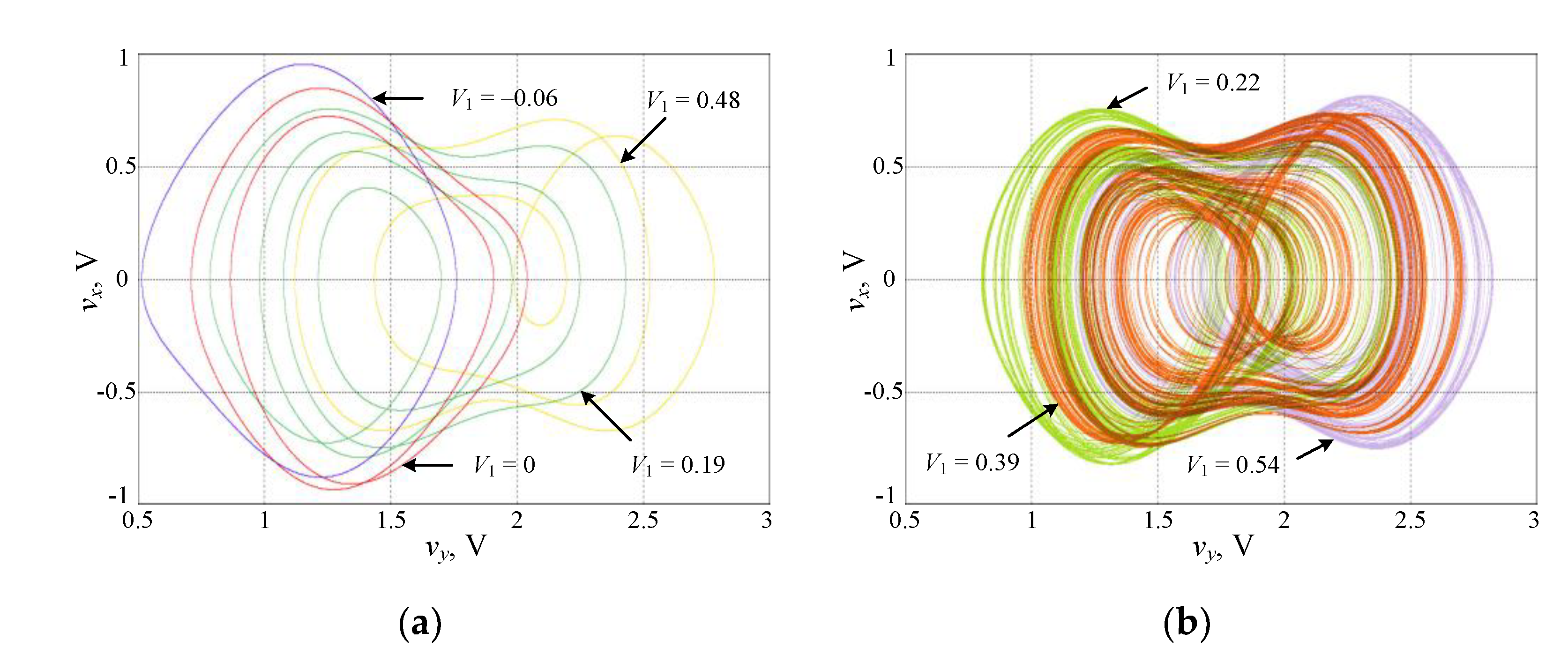Extreme Multistability and Its Incremental Integral Reconstruction in a Non-Autonomous Memcapacitive Oscillator
Abstract
:1. Introduction
2. Non-Autonomous Memcapacitive Oscillator and Its Extreme Multistability
2.1. Non-Autonomous Memcapacitive Oscillator
2.2. Initial-Condition-Dependent Extreme Multistability
3. Dimensionality Reduction Analysis of the Non-Autonomous Memcapacitive System
3.1. Non-Autonomous Dimensionality Reduction Model and Stability Analysis
3.2. Bifurcation Behaviors Induced by Initial-Condition-Related Parameters
4. Circuit Simulation for the Reconstructed System
5. Conclusions
Author Contributions
Funding
Institutional Review Board Statement
Informed Consent Statement
Data Availability Statement
Conflicts of Interest
References
- Chua, L.O. Memristor-The missing circuit element. IEEE Trans. Circuit Theory 1971, 18, 507–519. [Google Scholar] [CrossRef]
- Strukov, D.B.; Snider, G.S.; Stewart, D.R.; Williams, R.S. The missing memristor found. Nature 2008, 453, 80–83. [Google Scholar] [CrossRef]
- Ya, X.B.; Zhao, J.H.; Sen, L.; Zhou, Z.Y.; Liu, Q.; Chen, J.S.; Liu, X.Y. Memristor with Ag-cluster-doped TiO2 films as artificial synapse for neuroinspired computing. Adv. Func. Mater. 2018, 28, 1705320. [Google Scholar]
- Zhang, S.; Luo, S.J.; Xu, N.; Zou, Q.M.; Song, M.; Yun, J.J.; Luo, Q.; Guo, Z.; Li, R.F.; Tian, W.C.; et al. A spin-orbit-torque memristive device. Adv. Electron. Mater. 2019, 5, 1800782. [Google Scholar] [CrossRef]
- Zhang, W.; Mazzarello, R.; Wuttig, M.; Ma, E. Designing crystallization in phase-change materials for universal memory and neuro-inspired computing. Nat. Rev. Mater. 2019, 4, 150–168. [Google Scholar] [CrossRef]
- Chanthbouala, A.; Garcia, V.; Cherifi, R.O.; Bouzehouane, K.; Fusil, S.; Moya, X.; Xavier, X.; Yamada, H.; Deranlot, C.; Mathur, N.D.; et al. A ferroelectric memristor. Nat. Mater. 2012, 11, 860–864. [Google Scholar] [CrossRef]
- Ventra, M.D.; Pershin, Y.V.; Chua, L.O. Circuit elements with memory: Memristors, memcapacitors, and meminductors. Proc. IEEE 2009, 97, 1717–1724. [Google Scholar] [CrossRef] [Green Version]
- Demasius, K.; Kirschen, A.; Parkin, S. Energy-efficient memcapacitor devices for neuromorphic computing. Nat. Electron. 2021, 4, 748–756. [Google Scholar] [CrossRef]
- Najem, J.S.; Hasan, M.S.; Williams, R.S.; Weiss, R.J.; Rose, G.S.; Taylor, G.J.; Sarles, S.A.; Collier, C.P. Dynamical nonlinear memory capacitance in biomimetic membranes. Nat. Commun. 2019, 10, 3239. [Google Scholar] [CrossRef] [Green Version]
- Khan, A.K.; Lee, B.H. Monolayer MoS2 metal insulator transition based memcapacitor modeling with extension to a ternary device. AIP Adv. 2016, 6, 095022. [Google Scholar] [CrossRef] [Green Version]
- Kimura, M.; Ishisaki, Y.; Miyabe, Y.; Yoshida, H.; Ogawa, I.; Yokoyama, T.; Haga, K.I.; Tokumitsu, E.; Nakashima, Y. Neuromorphic system using memcapacitors and autonomous local learning. IEEE Trans. Neural Netw. Learn. Syst. 2021. [Google Scholar] [CrossRef]
- Sun, J.W.; Han, G.Y.; Wang, Y.F. Dynamical analysis of memcapacitor chaotic system and its image encryption application. Int. J. Control Autom. Syst. 2020, 18, 1242–1249. [Google Scholar] [CrossRef]
- Guo, M.; Yang, R.; Zhang, M.; Liu, R.Y.; Zhu, Y.L.; Dou, G. A novel memcapacitor and its application in a chaotic circuit. Nonlinear Dyn. 2021, 105, 877–886. [Google Scholar] [CrossRef]
- Chen, B.; Xu, Q.; Chen, M.; Wu, H.G.; Bao, B.C. Initial-condition-switched boosting extreme multistability and mechanism analysis in a memcapacitive oscillator. Front. Inform. Technol. Electron. Eng. 2021, 22, 1517–1531. [Google Scholar] [CrossRef]
- Yuan, F.; Li, Y.X. A chaotic circuit constructed by a memristor, a memcapacitor and a meminductor. Chaos 2019, 29, 101101. [Google Scholar] [CrossRef] [PubMed]
- Wang, X.Y.; Yu, J.; Jin, C.X.; Iu, H.H.C.; Yu, S.M. Chaotic oscillator based on memcapacitor and meminductor. Nonlinear Dyn. 2019, 96, 161–173. [Google Scholar] [CrossRef]
- Zhao, Q.; Wang, C.H.; Zhang, X. A universal emulator for memristor, memcapacitor, and meminductor and its chaotic circuit. Chaos 2019, 29, 013141. [Google Scholar] [CrossRef] [PubMed]
- Rajagopal, K.; Jafari, S.; Karthikeyan, A.; Srinivasan, A.; Ayele, B. Hyperchaoticmemcapacitor oscillator with infinite equilibria and coexisting attractors. Circuits Syst. Signal Process. 2018, 37, 3702–3724. [Google Scholar] [CrossRef]
- Rajagopal, K.; Karthikeyan, A.; Srinivasan, A. Dynamical analysis and FPGA implementation of a chaotic oscillator with fractional-order memristor components. Nonlinear Dyn. 2018, 91, 1491–1512. [Google Scholar] [CrossRef]
- Zhou, W.; Wang, G.Y.; Iu, H.H.C.; Shen, Y.R.; Liang, Y. Complex dynamics of a non-volatile memcapacitor-aided hyperchaotic oscillator. Nonlinear Dyn. 2020, 100, 3937–3957. [Google Scholar] [CrossRef]
- Ma, X.J.; Mou, J.; Liu, J.; Ma, C.G.; Yang, F.F.; Zhao, X. A novel simple chaotic circuit based on memristor-memcapacitor. Nonlinear Dyn. 2020, 100, 2859–2876. [Google Scholar] [CrossRef]
- Ngonghala, C.N.; Feudel, U.; Showalter, K. Extreme multistability in a chemical model system. Phys. Rev. E 2011, 83, 056206. [Google Scholar] [CrossRef] [PubMed] [Green Version]
- Bao, B.C.; Xu, Q.; Bao, H.; Chen, M. Extreme multistability in a memristive circuit. Electron. Lett. 2016, 52, 1008–1009. [Google Scholar] [CrossRef]
- Chen, M.; Sun, M.X.; Bao, H.; Hu, Y.H.; Bao, B.C. Flux-charge analysis of two-memristor-based Chua’s circuit: Dimensionality decreasing model for detecting extreme multistability. IEEE Trans. Ind. Electron. 2020, 67, 2197–2206. [Google Scholar] [CrossRef]
- Zhang, H.Y.; Sun, K.H.; He, S.B. A fractional-order ship power system with extreme multistability. Nonlinear Dyn. 2021, 106, 1027–1040. [Google Scholar] [CrossRef]
- Zhang, L.P.; Liu, Y.; Wei, Z.C.; Jiang, H.B.; Bi, Q.S. A novel class of two-dimensional chaotic maps with infinitely many coexisting attractors. Chin. Phys. B 2020, 29, 060501. [Google Scholar] [CrossRef]
- Wu, H.G.; Ye, Y.; Bao, B.C.; Chen, M.; Xu, Q. Memristor initial boosting behaviors in a two-memristor-based hyperchaotic system. Chaos Solit. Fract. 2019, 121, 178–185. [Google Scholar] [CrossRef]
- Li, C.B.; Peng, Y.X.; Tao, Z.; Sprott, J.C.; Jafari, S. Coexisting Infinite Equilibria and Chaos. Int. J. Bifurc. Chaos 2021, 31, 2130014. [Google Scholar] [CrossRef]
- Bao, H.; Ding, R.Y.; Wu, H.G.; Chen, B. Initial-condition effects on a two-memristor-based Jerk system. Mathematics 2022, 10, 411. [Google Scholar] [CrossRef]
- Bao, H.; Chen, M.; Wu, H.G.; Bao, B.C. Memristor initial-boosted coexisting plane bifurcations and its extreme multi-stability reconstitution in two-memristor-based dynamical system. Sci. China Tech. Sci. 2020, 63, 77–87. [Google Scholar] [CrossRef]
- Pham, V.T.; Volos, C.K.; Kapitaniak, T.; Jafari, S.; Wang, X. Dynamics and circuit of a chaotic system with a curve of equilibrium points. Int. J. Electron. 2018, 105, 385–397. [Google Scholar] [CrossRef]
- Akgul, A.; Kengne, J.; Rajagopal, K.; Pham, V.T.; Varan, M.; Karthikeyan, A.; Guleryuz, E.; Kutlu, M.C. Simulation and experimental implementations of memcapacitor based multi-stable chaotic oscillator and its dynamical analysis. Phys. Scr. 2021, 96, 015209. [Google Scholar] [CrossRef]
- Chen, B.; Cheng, X.X.; Wu, H.G.; Bao, B.C.; Xu, Q. Infinitely many necklace-shaped coexisting attractors in a nonautonomous memcapacitive oscillator. Int. J. Bifurc. Chaos 2022, 32, 2250028. [Google Scholar] [CrossRef]
- Bao, H.; Liu, W.B.; Chen, M. Hidden extreme multistability and dimensionality reduction analysis for an improved non-autonomous memristiveFitzHugh-Nagumo circuit. Nonlinear Dyn. 2019, 96, 1879–1894. [Google Scholar] [CrossRef]
- Chen, M.; Qi, J.W.; Xu, Q.; Bao, B.C. Quasi-period, periodic bursting and bifurcations in memristor-based FitzHugh-Nagumo circuit. Int. J. Electron. Commun. 2019, 110, 152840. [Google Scholar] [CrossRef]
- Xu, Q.; Liu, T.; Feng, C.T.; Bao, H.; Wu, H.G.; Bao, B.C. Continuous non-autonomous memristive Rulkov model with extreme multistability. Chin. Phys. B 2021, 30, 128702. [Google Scholar] [CrossRef]
- Corinto, F.; Forti, M. Memristor circuits: Bifurcations without parameters. IEEE Trans. Circuits Syst. I Reg. Pap. 2017, 64, 1540–1551. [Google Scholar] [CrossRef]
- Corinto, F.; Forti, M. Memristor Circuits: Flux-charge analysis method. IEEE Trans. Circuits Syst. I Reg. Pap. 2016, 63, 1997–2009. [Google Scholar] [CrossRef] [Green Version]
- Bao, B.C.; Zhu, Y.X.; Li, C.Q.; Bao, H.; Xu, Q. Global multistability and analog circuit implementation of an adapting synapse-based neuron model. Nonlinear Dyn. 2021, 101, 1105–1118. [Google Scholar] [CrossRef]
- Pham, V.T.; Vaidyanathan, S.; Volos, C.K.; Jafari, S.; Kuznetsov, N.V.; Hoang, T.M. A novel memristive time-delay chaotic system without equilibrium points. Eur. Phys. J. Spec. Top. 2016, 225, 127–136. [Google Scholar] [CrossRef]
- Xu, Q.; Ju, Z.T.; Ding, S.K.; Feng, C.T.; Chen, M.; Bao, B.C. Electromagnetic induction effects on electrical activity within a memristive Wilson neuron model. Cogn. Neurodyn. 2022. [Google Scholar] [CrossRef]
- Pham, V.T.; Jafari, S.; Vaidyanathan, S.; Volos, C.; Wang, X. A novel memristive neural network with hidden attractors and its circuitry implementation. Sci. China Tech. Sci. 2016, 59, 358–363. [Google Scholar] [CrossRef]










Publisher’s Note: MDPI stays neutral with regard to jurisdictional claims in published maps and institutional affiliations. |
© 2022 by the authors. Licensee MDPI, Basel, Switzerland. This article is an open access article distributed under the terms and conditions of the Creative Commons Attribution (CC BY) license (https://creativecommons.org/licenses/by/4.0/).
Share and Cite
Chen, B.; Cheng, X.; Bao, H.; Chen, M.; Xu, Q. Extreme Multistability and Its Incremental Integral Reconstruction in a Non-Autonomous Memcapacitive Oscillator. Mathematics 2022, 10, 754. https://doi.org/10.3390/math10050754
Chen B, Cheng X, Bao H, Chen M, Xu Q. Extreme Multistability and Its Incremental Integral Reconstruction in a Non-Autonomous Memcapacitive Oscillator. Mathematics. 2022; 10(5):754. https://doi.org/10.3390/math10050754
Chicago/Turabian StyleChen, Bei, Xinxin Cheng, Han Bao, Mo Chen, and Quan Xu. 2022. "Extreme Multistability and Its Incremental Integral Reconstruction in a Non-Autonomous Memcapacitive Oscillator" Mathematics 10, no. 5: 754. https://doi.org/10.3390/math10050754
APA StyleChen, B., Cheng, X., Bao, H., Chen, M., & Xu, Q. (2022). Extreme Multistability and Its Incremental Integral Reconstruction in a Non-Autonomous Memcapacitive Oscillator. Mathematics, 10(5), 754. https://doi.org/10.3390/math10050754






